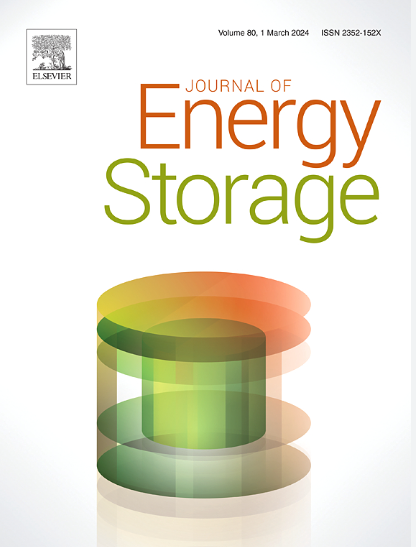Fast oxidation fabrication of nanosized BiOCl-embedded 1D carbon nanofibers as a novel aqueous zinc-ion batteries cathode
IF 8.9
2区 工程技术
Q1 ENERGY & FUELS
引用次数: 0
Abstract
BiOCl is recognized as one of the promising candidates for aqueous zinc ion batteries (ZIBs) due to its large layer space and high theoretical capacity, but its semiconducting nature and large volume change result in low capacity and poor cycling stability. Herein, BiOCl nanosheets tightly anchored on carbon fibers (BiOCl@CF) self-supported electrode was prepared via a fast oxidation method that just infiltrates Bi@CFs in a solution (VH2O2:VHCl = 49:1) for 9 min. Owing thin BiOCl nanosheets with the increased adsorption energy bring accelerated ion transfer, while the cross-linked conductive networks of CFs not only improve charge transfer but also remiss volume expansion during cycling. These features endow BiOCl@CF with outstanding capacity (118.8 mAh g−1 after 200 cycles at 0.2 A g−1), excellent rate performances (67.0 mAh g−1 at 1 A g−1), and long cycle life (97.1 % capacity retention rate over 2000 cycles). Importantly, the reaction mechanism of BiOCl@CF was confirmed by many ex-situ technologies, revealing the conversion storage zinc process. Overall, this work provides a new perspective for the development of high-performance cathode materials for ZIBs.
快速氧化法制备包埋biocl纳米一维碳纳米纤维作为新型锌离子电池正极材料
BiOCl由于其大的层空间和高的理论容量而被公认为是有前途的水性锌离子电池(zib)的候选者之一,但其半导体性质和大的体积变化导致容量低,循环稳定性差。本文采用快速氧化法将BiOCl纳米片紧密锚定在碳纤维(BiOCl@CF)自持电极上,在溶液(VH2O2:VHCl = 49:1)中仅浸润Bi@CFs 9 min。拥有吸附能增加的薄BiOCl纳米片加速了离子转移,而碳纤维的交联导电网络不仅提高了电荷转移,而且在循环过程中避免了体积膨胀。这些特性使BiOCl@CF具有出色的容量(在0.2 A g−1下200次循环后为118.8 mAh g−1),优异的倍率性能(在1 A g−1下为67.0 mAh g−1)和长循环寿命(在2000次循环后容量保持率为97.1%)。重要的是,BiOCl@CF的反应机理被许多非原位技术证实,揭示了转化储存锌的过程。本研究为ZIBs高性能正极材料的开发提供了新的思路。
本文章由计算机程序翻译,如有差异,请以英文原文为准。
求助全文
约1分钟内获得全文
求助全文
来源期刊

Journal of energy storage
Energy-Renewable Energy, Sustainability and the Environment
CiteScore
11.80
自引率
24.50%
发文量
2262
审稿时长
69 days
期刊介绍:
Journal of energy storage focusses on all aspects of energy storage, in particular systems integration, electric grid integration, modelling and analysis, novel energy storage technologies, sizing and management strategies, business models for operation of storage systems and energy storage developments worldwide.
 求助内容:
求助内容: 应助结果提醒方式:
应助结果提醒方式:


